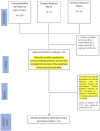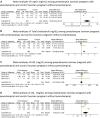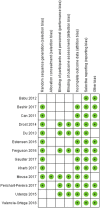Association of LEPTIN and other inflammatory markers with preeclampsia: A systematic review
- PMID: 36034841
- PMCID: PMC9399808
- DOI: 10.3389/fphar.2022.966400
Association of LEPTIN and other inflammatory markers with preeclampsia: A systematic review
Abstract
Background: Preeclampsia is a serious pregnancy complication that affects 5%-10% of the obstetric population. Objective: To study inflammatory markers associated with preeclampsia. Search Strategy: Searches of articles on the topic published over a 10-year period (2009-2019) were performed in three databases (PubMed, Cochrane, and Embase) using the keywords preeclampsia and inflammatory markers. The PubMed search using 10 years and humans as filters retrieved 124 articles. Using an advanced search strategy, 0 articles were identified in Embase and 10 articles in Cochrane. After screening and eligibility assessment, 13 articles were included in the systematic review and meta-analysis. Meta-analysis and quality assessment of the studies were performed using the Review Manager 5.3 program. Results: For meta-analysis, women with preeclampsia were compared to control women, i.e., pregnancies without arterial hypertension. Leptin levels were significantly higher (p < 0.0002) in women with preeclampsia compared to controls. Total cholesterol was also significantly elevated in women with preeclampsia (p < 0.0001). There was no significant difference in HDL between groups, but women with preeclampsia had significantly increased LDL (p < 0.01). The same was observed for triglycerides, which were significantly increased in women with preeclampsia (p < 0.04) compared to controls. Analysis of TNF-alpha, an important inflammatory marker, showed higher levels in women with preeclampsia (p < 0.03) compared to controls. The same was observed for another important inflammatory marker, interleukin 6, which was significantly increased in women with preeclampsia (p < 0.0002). There was a significant increase of C-reactive protein in women with preeclampsia (p < 0.003) compared to controls. Conclusion: Women with preeclampsia have increased levels of inflammatory markers compared to control women.
Keywords: C reaction protein; HDL; inflammatory; markers; preeclaimpsia.
Copyright © 2022 Veiga, Korkes, Salomão and Cavalli.
Conflict of interest statement
The authors declare that the research was conducted in the absence of any commercial or financial relationships that could be construed as a potential conflict of interest.
Figures





Similar articles
-
Maternal hyperlipidemia and the risk of preeclampsia: a meta-analysis.Am J Epidemiol. 2014 Aug 15;180(4):346-58. doi: 10.1093/aje/kwu145. Epub 2014 Jul 2. Am J Epidemiol. 2014. PMID: 24989239 Free PMC article.
-
Serum biomarkers for the prediction and diagnosis of preeclampsia: A meta-analysis.J Taibah Univ Med Sci. 2021 Aug 11;17(1):14-27. doi: 10.1016/j.jtumed.2021.07.003. eCollection 2022 Feb. J Taibah Univ Med Sci. 2021. PMID: 35140561 Free PMC article.
-
Platelet function in preeclampsia - a systematic review and meta-analysis.Platelets. 2019;30(5):549-562. doi: 10.1080/09537104.2019.1595561. Epub 2019 Apr 14. Platelets. 2019. PMID: 30983478
-
Obstetrical complications associated with abnormal maternal serum markers analytes.J Obstet Gynaecol Can. 2008 Oct;30(10):918-932. doi: 10.1016/S1701-2163(16)32973-5. J Obstet Gynaecol Can. 2008. PMID: 19038077 Review. English, French.
-
The Effect of Dietary Fibre on Gut Microbiota, Lipid Profile, and Inflammatory Markers in Patients with Type 2 Diabetes: A Systematic Review and Meta-Analysis of Randomised Controlled Trials.Nutrients. 2021 May 26;13(6):1805. doi: 10.3390/nu13061805. Nutrients. 2021. PMID: 34073366 Free PMC article.
Cited by
-
Raised levels of chemerin in women with preeclampsia: A meta-analysis.Biomol Biomed. 2024 May 2;24(3):454-464. doi: 10.17305/bb.2023.9671. Biomol Biomed. 2024. PMID: 37782564 Free PMC article.
-
FSP1 and CoQ10 have the potential to serve as biomarkers for severe preeclampsia.BMC Pregnancy Childbirth. 2025 Aug 6;25(1):813. doi: 10.1186/s12884-025-07930-4. BMC Pregnancy Childbirth. 2025. PMID: 40770312 Free PMC article.
-
Adipokines in preeclampsia: disrupted signaling pathways and novel therapeutic strategies.Eur J Med Res. 2025 Aug 4;30(1):702. doi: 10.1186/s40001-025-02972-y. Eur J Med Res. 2025. PMID: 40759967 Free PMC article. Review.
-
Nutrigenetic Investigations in Preeclampsia.Nutrients. 2024 Sep 26;16(19):3248. doi: 10.3390/nu16193248. Nutrients. 2024. PMID: 39408215 Free PMC article.
-
Protocol for a randomised controlled trial of a weight maintenance intervention to promote fat loss in pregnant individuals with obesity.BMJ Open. 2025 Feb 25;15(2):e095804. doi: 10.1136/bmjopen-2024-095804. BMJ Open. 2025. PMID: 40000086 Free PMC article.
References
-
- Beneventi F., Locatelli E., de Amici M., Cavagnoli C., Bellingeri C., de Maggio I., et al. (2020). Maternal and fetal Leptin and interleukin 33 concentrations in pregnancy complicated by obesity and preeclampsia. J. Maternal-Fetal Neonatal Med. 33, 3942–3948. 10.1080/14767058.2019.1593359 - DOI - PubMed
Publication types
LinkOut - more resources
Full Text Sources
Research Materials

